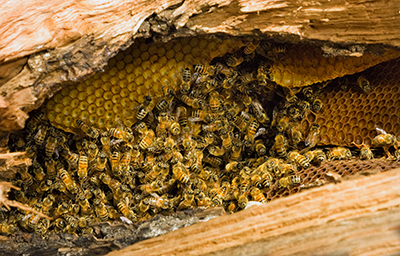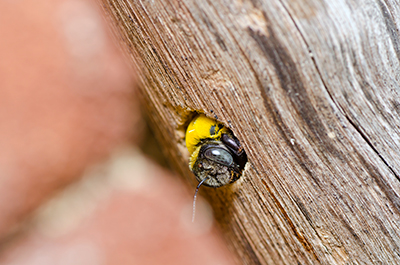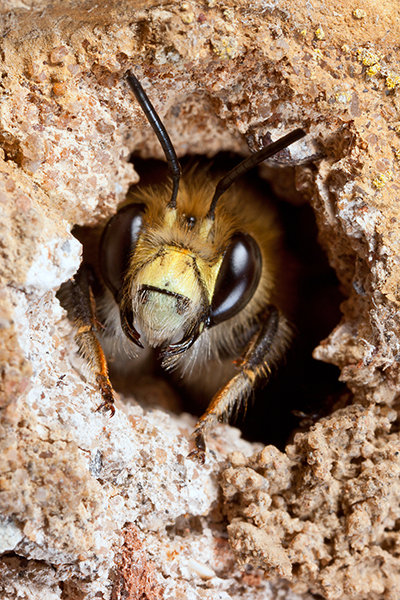How to Get Rid of Bees – Aren’t They Beneficial? What’s the Problem?
 Bees provide an extremely beneficial value to all of us, pollinating over 100 crops in the U.S. alone. In recent years, honey bee populations have been declining due in part to the application of systemic pesticides to crops. If bees were to disappear, our environment, health and livelihood would be greatly damaged.
Bees provide an extremely beneficial value to all of us, pollinating over 100 crops in the U.S. alone. In recent years, honey bee populations have been declining due in part to the application of systemic pesticides to crops. If bees were to disappear, our environment, health and livelihood would be greatly damaged.
So, with these thoughts in mind, why would we be writing an article entitled, “How to Get Rid of Bees”?
How to Get Rid of Bees – Where Bees Can Become A Problem
Bees, in nature, do provide an highly essential function. In fact, so do termites. Termites break down dead wood in nature, making it available to enrich the soil. Where bees and termites become a problem is when they take up their dwelling in your home or, in some cases, in a problem location on your property.
How to Get Rid of Bees – Damage Caused by Bees
Honey Bees
 Even the beloved honey bee can wreck havoc on a house. In many cases, honey bees will take up residence within the walls of a house. There, they will occupy from 4-9 gallons of space filling the wall with honey. Beyond that, they have been known to secrete water onto the surrounding Sheetrock, dissolving the Sheetrock in order to expand their hive. In some cases they may actually break through to the inside of a house and begin flying around by the hundreds–definitely not a desirable situation. So, a homeowner may apply insecticide, killing the bees. Now there are gallons of honey remaining inside the wall. The honey attracts a host of other pests including ants, cockroaches, mice, rats… all pests that love sweet food. Now you have a real problem.
Even the beloved honey bee can wreck havoc on a house. In many cases, honey bees will take up residence within the walls of a house. There, they will occupy from 4-9 gallons of space filling the wall with honey. Beyond that, they have been known to secrete water onto the surrounding Sheetrock, dissolving the Sheetrock in order to expand their hive. In some cases they may actually break through to the inside of a house and begin flying around by the hundreds–definitely not a desirable situation. So, a homeowner may apply insecticide, killing the bees. Now there are gallons of honey remaining inside the wall. The honey attracts a host of other pests including ants, cockroaches, mice, rats… all pests that love sweet food. Now you have a real problem.
 Note that honey bees swarming on or near your home are swarming around their queen, looking for a new home to occupy. The huge ball of bees, though it looks threatening, is generally not dangerous, unless provoked. And, a bee keeper may be able to transport that swarm to a new home in some agricultural area where it will provide a great benefit. It can be a win-win situation for you and for the bees!
Note that honey bees swarming on or near your home are swarming around their queen, looking for a new home to occupy. The huge ball of bees, though it looks threatening, is generally not dangerous, unless provoked. And, a bee keeper may be able to transport that swarm to a new home in some agricultural area where it will provide a great benefit. It can be a win-win situation for you and for the bees!
Carpenter Bees
 Consider the carpenter bee. They are solitary individuals, and not likely to sting. However, they bore into a wooden structure like a deck or play structure, or the siding of a home. Over time, they’ll expand their home, and have been known to completely bore through an outside wall and emerge into a house. The holes they create can host other pests, invite moisture damage and thus compromise the integrity of a wooden structure.
Consider the carpenter bee. They are solitary individuals, and not likely to sting. However, they bore into a wooden structure like a deck or play structure, or the siding of a home. Over time, they’ll expand their home, and have been known to completely bore through an outside wall and emerge into a house. The holes they create can host other pests, invite moisture damage and thus compromise the integrity of a wooden structure.
Ground Bees
 Then, there’s the ground bee. Like carpenter bees, ground bees are solitary individuals, unlikely to sting unless greatly provoked. They make their nest in weak, unhealthy dry lawns. You’re likely to see a number of nests in an area. It can be a bit unnerving and make relaxing in your backyard difficult amidst the buzzing of the bees. But beyond that, yellow jackets also live in holes in the ground, and are attracted to similar soil conditions. Imagine thinking you’re happily tolerating ground bees, only to find a similar looking hole you just stepped on contained a yellow jacket nest.
Then, there’s the ground bee. Like carpenter bees, ground bees are solitary individuals, unlikely to sting unless greatly provoked. They make their nest in weak, unhealthy dry lawns. You’re likely to see a number of nests in an area. It can be a bit unnerving and make relaxing in your backyard difficult amidst the buzzing of the bees. But beyond that, yellow jackets also live in holes in the ground, and are attracted to similar soil conditions. Imagine thinking you’re happily tolerating ground bees, only to find a similar looking hole you just stepped on contained a yellow jacket nest.
Bumble Bees
 The bumble bee, like the honey bee, is a highly beneficial pollinator. They tend to take up residence in an old abandoned mattress, car cushion or out building. Like the other bees, they are non-aggressive and not likely to sting. However, if their nest is near a walkway or area you frequent, they can become aggressive.
The bumble bee, like the honey bee, is a highly beneficial pollinator. They tend to take up residence in an old abandoned mattress, car cushion or out building. Like the other bees, they are non-aggressive and not likely to sting. However, if their nest is near a walkway or area you frequent, they can become aggressive.
How to Get Rid of Bees – Prevention is the first line of defense.
So, though bees are beneficial in nature, they can become a problem if they take up dwelling in or around your home. Here are a few tips for encouraging bees not to live in the place you occupy. And note that these same tips will also make your home and property less friendly to mice, rats and other pests:
- Remove rubbish from your yard (dead wood, stacks of wood, used mattresses, any object that might make a good home for bees).
- Water and fertilize your lawn and garden, keeping it healthy and trimmed. And, trim all trees and plantings six inches to a foot away from your house.
- Seal up all cracks and openings in your home’s foundation, siding, roofing, around gutters, doors and windows. Make sure that ceiling and wall vents are well screened. Openings invite bees and other pests.
Observing these 3 simple tips will help make your home an uninviting place for bees and other pests.
How to Get Rid of Bees – They’ll let you know how well you did.
If you do encounter a bee problem, or a problem with other pests, realize they are great opportunists. They’ll discover any opening or suitable place to make a home. And, if a few bees begin to create a happy home, you can be sure that they’re finding conditions favorable to other pests. It’s only a matter of time until the others begin to move in.
So, when you see the beginnings of a bee infestation, immediately remove the conditions that favor that infestation.
How to Get Rid of Bees – Call ApolloX Pest Control
It’s wise to call in a licensed pest control professional. A professional will not only safely eliminate the problem, but will assess any damage to your home and suggest needed repairs. In addition, at ApolloX Pest Control, we never just deal with the one issue we were called in to treat. We naturally inspect the surrounding area for the presence of other pests, and for conditions favorable to pests. One visit can nip a pest problem in the bud, and also prevent future expensive problems along with damage to your home and health hazard to your family.
If you discover a bee problem…












Recent Comments